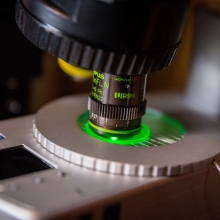Portrait of a supernova
Weizmann scientists map out data from a stellar explosion
Briefs

This image of Supernova 2023ixf, which occurred in Messier 101, was made using telescope data from the nights of May 21, 22 and 23, 2023. (Credit: Travis Deyoe, Mount Lemmon SkyCenter, University of Arizona. Hosseinzadeh et al. 2023.)
What causes stars to explode? Accounts of witnessing supernovae—exploding stars—date back thousands of years, yet the reasons behind this fascinating—and exceedingly rare—phenomenon remain a mystery. Weizmann scientists have now made major headway toward better understanding that process—which is responsible for the formation of elements like oxygen, calcium, and iron, the building blocks of life itself. Through a combination of luck and determination, the team, led by Prof. Avishay Gal-Yam from the Department of Particle Physics and Astrophysics, gathered data from a once-in-a-lifetime supernova.
Supernovae are extremely rare events, occurring in our galaxy once a century, at most; the last such event in the Milky Way Galaxy took place hundreds of years ago. Although advances in telescope technology help identify supernovae in distant galaxies, by supplying much more data than was previously possible, the same problem persists: Since we are unable to predict the occurrence of an explosion, astrophysicists must play the part of celestial cold-case detectives, examining the evidence long after the event occurred and trying to cobble together an explanation.
The scientists are the first to admit that they were extremely lucky. Prof. Gal-Yam’s team had applied for research time on NASA’s Hubble Space Telescope, hoping to gather UV spectral data on a supernova that occurred within a gas-rich environment. Instead, they got the chance to witness, in real time, one of the closest supernovae in decades: a red supergiant star exploding in Messier 101, a neighboring galaxy also known as the Pinwheel Galaxy.
Says Erez Zimmerman, a PhD student in Prof. Gal-Yam’s group, “We were able—for the very first time—to closely follow a supernova while its light was emerging from the circumstellar material in which the exploding star was embedded.” In simpler terms, this was like getting to the scene of the crime while it was still taking place.
Of course, while fortuitous timing provided the opportunity and the means, the researchers still needed to gather the data, which required a lot of work. The supernova was discovered on a Friday, the beginning of the weekend in Israel and right before the weekend at Baltimore’s Space Telescope Science Institute, the operations center for the Hubble Telescope. Complicating things even further, this was all taking place two days before Zimmerman’s wedding. The team persevered and pulled an all-nighter, delivering the necessary measurements to NASA—that is, the correct reorientation of the sluggish telescope—just in time to observe the explosion.
As the Hubble Telescope had already made recordings in this sector of the universe many times before, by turning to the NASA archives, the Gal-Yam team and other groups were able to gather data from before the star’s eventual demise—when it was still just a red supergiant in its final stages of life— thus creating the most complete portrait of a supernova ever.
Fortunately, their determination paid off. Analyzing the UV and X-ray data received from NASA’s Hubble and Swift satellites, as well as many of the best telescopes across the globe, the researchers were able to map out the two outer layers of the exploding star and come up with an extraordinary hypothesis—that mass from the star ended up in a black hole that was formed in the aftermath of the explosion, something that is usually very hard to determine.
Their otherworldly findings were published in Nature in March.
What will happen to the matter that composed Messier 101’s former red supergiant? We may never know, but the supernova is still ongoing and new data is coming in. A whole new world is beginning.
AVISHAY GAL-YAM IS SUPPORTED BY:
-
Norman E. Alexander Family M Foundation Data Center
-
André Deloro Institute for Space and Optics Research
-
Arlyn Imberman Professorial Chair








